LSBM306 Strategy: Evaluating LEGO's Key Innovation Drivers & Success
VerifiedAdded on 2023/05/28
|14
|3790
|108
Case Study
AI Summary
This case study delves into the strategic innovations that propelled LEGO to success, beginning with Ole Kirk Kristiansen's founding of the company and its evolution from wooden toys to the iconic LEGO brick. It highlights the importance of relinking innovation and business through the Design for Business (D4B) model, which fostered cooperation between teams and integrated design into the company's overall strategy. The study analyzes LEGO's proactive innovation process, including the introduction of Product and Marketing Development (PMD) and the concept lab, which focused on developing new products and physical play concepts. Furthermore, it emphasizes the significance of customer engagement, the adoption of a full spectrum of innovation exemplified by Bionicle, and the strategic delegation of management. The case study also examines LEGO's efforts to expand into untapped markets, customize products, and leverage consumer insights through panels and biometric coding. Ultimately, it underscores the company's ability to streamline its business and product portfolios, ensuring alignment between core values and financial performance, leading to sustained success and growth.

LEGO 1
LEGO
Name
Course
Tutor
University
City/State
Date
LEGO
Name
Course
Tutor
University
City/State
Date
Paraphrase This Document
Need a fresh take? Get an instant paraphrase of this document with our AI Paraphraser
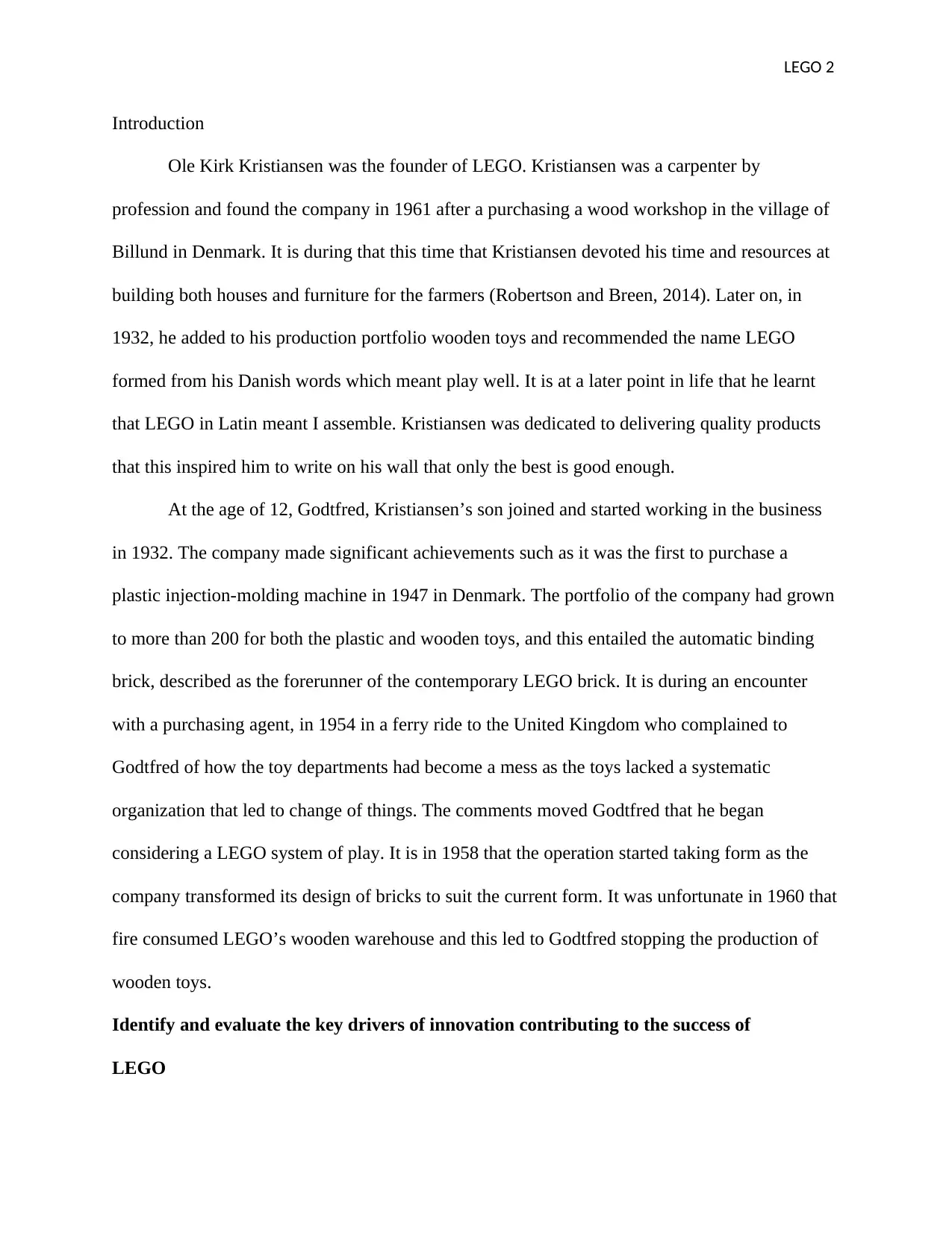
LEGO 2
Introduction
Ole Kirk Kristiansen was the founder of LEGO. Kristiansen was a carpenter by
profession and found the company in 1961 after a purchasing a wood workshop in the village of
Billund in Denmark. It is during that this time that Kristiansen devoted his time and resources at
building both houses and furniture for the farmers (Robertson and Breen, 2014). Later on, in
1932, he added to his production portfolio wooden toys and recommended the name LEGO
formed from his Danish words which meant play well. It is at a later point in life that he learnt
that LEGO in Latin meant I assemble. Kristiansen was dedicated to delivering quality products
that this inspired him to write on his wall that only the best is good enough.
At the age of 12, Godtfred, Kristiansen’s son joined and started working in the business
in 1932. The company made significant achievements such as it was the first to purchase a
plastic injection-molding machine in 1947 in Denmark. The portfolio of the company had grown
to more than 200 for both the plastic and wooden toys, and this entailed the automatic binding
brick, described as the forerunner of the contemporary LEGO brick. It is during an encounter
with a purchasing agent, in 1954 in a ferry ride to the United Kingdom who complained to
Godtfred of how the toy departments had become a mess as the toys lacked a systematic
organization that led to change of things. The comments moved Godtfred that he began
considering a LEGO system of play. It is in 1958 that the operation started taking form as the
company transformed its design of bricks to suit the current form. It was unfortunate in 1960 that
fire consumed LEGO’s wooden warehouse and this led to Godtfred stopping the production of
wooden toys.
Identify and evaluate the key drivers of innovation contributing to the success of
LEGO
Introduction
Ole Kirk Kristiansen was the founder of LEGO. Kristiansen was a carpenter by
profession and found the company in 1961 after a purchasing a wood workshop in the village of
Billund in Denmark. It is during that this time that Kristiansen devoted his time and resources at
building both houses and furniture for the farmers (Robertson and Breen, 2014). Later on, in
1932, he added to his production portfolio wooden toys and recommended the name LEGO
formed from his Danish words which meant play well. It is at a later point in life that he learnt
that LEGO in Latin meant I assemble. Kristiansen was dedicated to delivering quality products
that this inspired him to write on his wall that only the best is good enough.
At the age of 12, Godtfred, Kristiansen’s son joined and started working in the business
in 1932. The company made significant achievements such as it was the first to purchase a
plastic injection-molding machine in 1947 in Denmark. The portfolio of the company had grown
to more than 200 for both the plastic and wooden toys, and this entailed the automatic binding
brick, described as the forerunner of the contemporary LEGO brick. It is during an encounter
with a purchasing agent, in 1954 in a ferry ride to the United Kingdom who complained to
Godtfred of how the toy departments had become a mess as the toys lacked a systematic
organization that led to change of things. The comments moved Godtfred that he began
considering a LEGO system of play. It is in 1958 that the operation started taking form as the
company transformed its design of bricks to suit the current form. It was unfortunate in 1960 that
fire consumed LEGO’s wooden warehouse and this led to Godtfred stopping the production of
wooden toys.
Identify and evaluate the key drivers of innovation contributing to the success of
LEGO
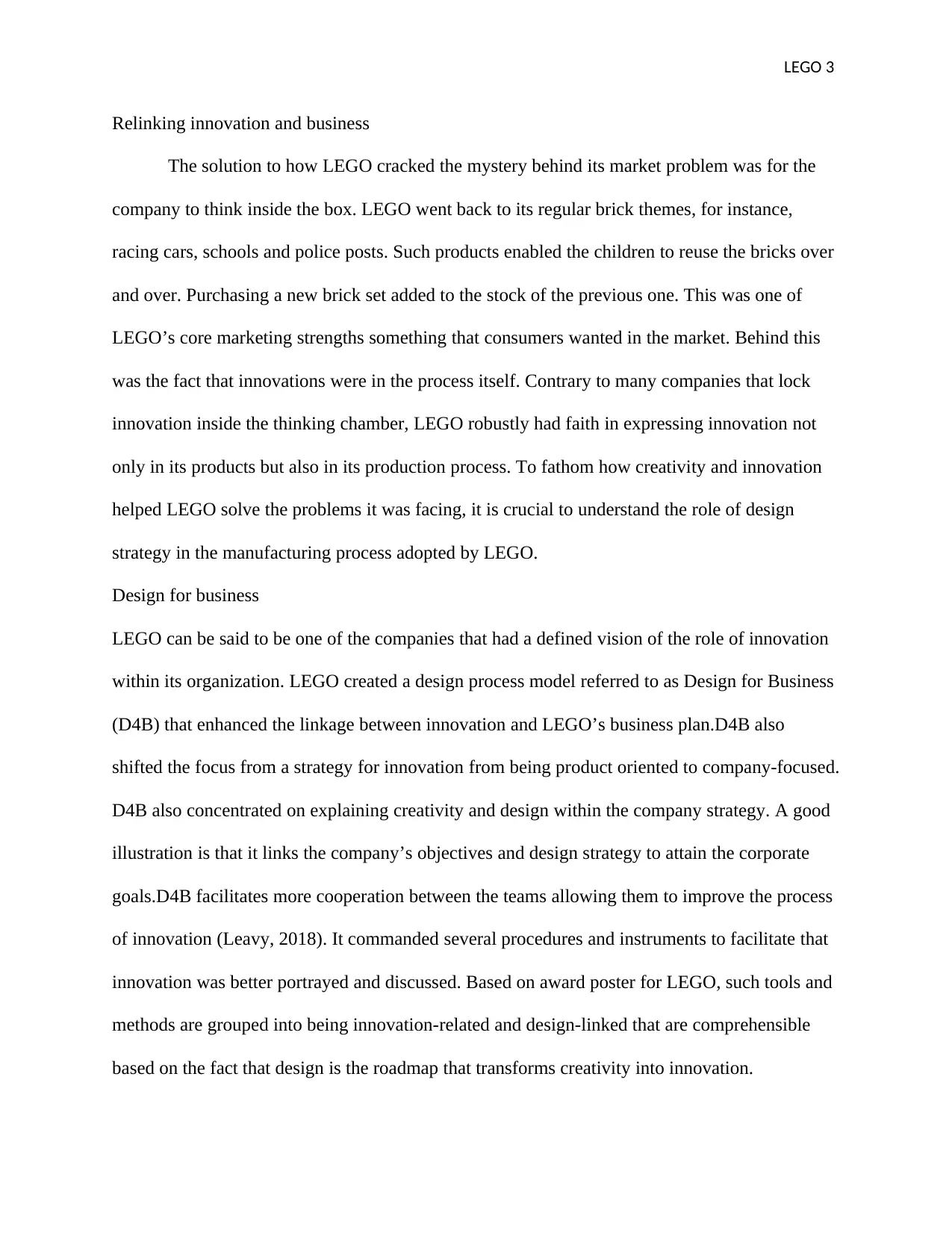
LEGO 3
Relinking innovation and business
The solution to how LEGO cracked the mystery behind its market problem was for the
company to think inside the box. LEGO went back to its regular brick themes, for instance,
racing cars, schools and police posts. Such products enabled the children to reuse the bricks over
and over. Purchasing a new brick set added to the stock of the previous one. This was one of
LEGO’s core marketing strengths something that consumers wanted in the market. Behind this
was the fact that innovations were in the process itself. Contrary to many companies that lock
innovation inside the thinking chamber, LEGO robustly had faith in expressing innovation not
only in its products but also in its production process. To fathom how creativity and innovation
helped LEGO solve the problems it was facing, it is crucial to understand the role of design
strategy in the manufacturing process adopted by LEGO.
Design for business
LEGO can be said to be one of the companies that had a defined vision of the role of innovation
within its organization. LEGO created a design process model referred to as Design for Business
(D4B) that enhanced the linkage between innovation and LEGO’s business plan.D4B also
shifted the focus from a strategy for innovation from being product oriented to company-focused.
D4B also concentrated on explaining creativity and design within the company strategy. A good
illustration is that it links the company’s objectives and design strategy to attain the corporate
goals.D4B facilitates more cooperation between the teams allowing them to improve the process
of innovation (Leavy, 2018). It commanded several procedures and instruments to facilitate that
innovation was better portrayed and discussed. Based on award poster for LEGO, such tools and
methods are grouped into being innovation-related and design-linked that are comprehensible
based on the fact that design is the roadmap that transforms creativity into innovation.
Relinking innovation and business
The solution to how LEGO cracked the mystery behind its market problem was for the
company to think inside the box. LEGO went back to its regular brick themes, for instance,
racing cars, schools and police posts. Such products enabled the children to reuse the bricks over
and over. Purchasing a new brick set added to the stock of the previous one. This was one of
LEGO’s core marketing strengths something that consumers wanted in the market. Behind this
was the fact that innovations were in the process itself. Contrary to many companies that lock
innovation inside the thinking chamber, LEGO robustly had faith in expressing innovation not
only in its products but also in its production process. To fathom how creativity and innovation
helped LEGO solve the problems it was facing, it is crucial to understand the role of design
strategy in the manufacturing process adopted by LEGO.
Design for business
LEGO can be said to be one of the companies that had a defined vision of the role of innovation
within its organization. LEGO created a design process model referred to as Design for Business
(D4B) that enhanced the linkage between innovation and LEGO’s business plan.D4B also
shifted the focus from a strategy for innovation from being product oriented to company-focused.
D4B also concentrated on explaining creativity and design within the company strategy. A good
illustration is that it links the company’s objectives and design strategy to attain the corporate
goals.D4B facilitates more cooperation between the teams allowing them to improve the process
of innovation (Leavy, 2018). It commanded several procedures and instruments to facilitate that
innovation was better portrayed and discussed. Based on award poster for LEGO, such tools and
methods are grouped into being innovation-related and design-linked that are comprehensible
based on the fact that design is the roadmap that transforms creativity into innovation.
⊘ This is a preview!⊘
Do you want full access?
Subscribe today to unlock all pages.

Trusted by 1+ million students worldwide
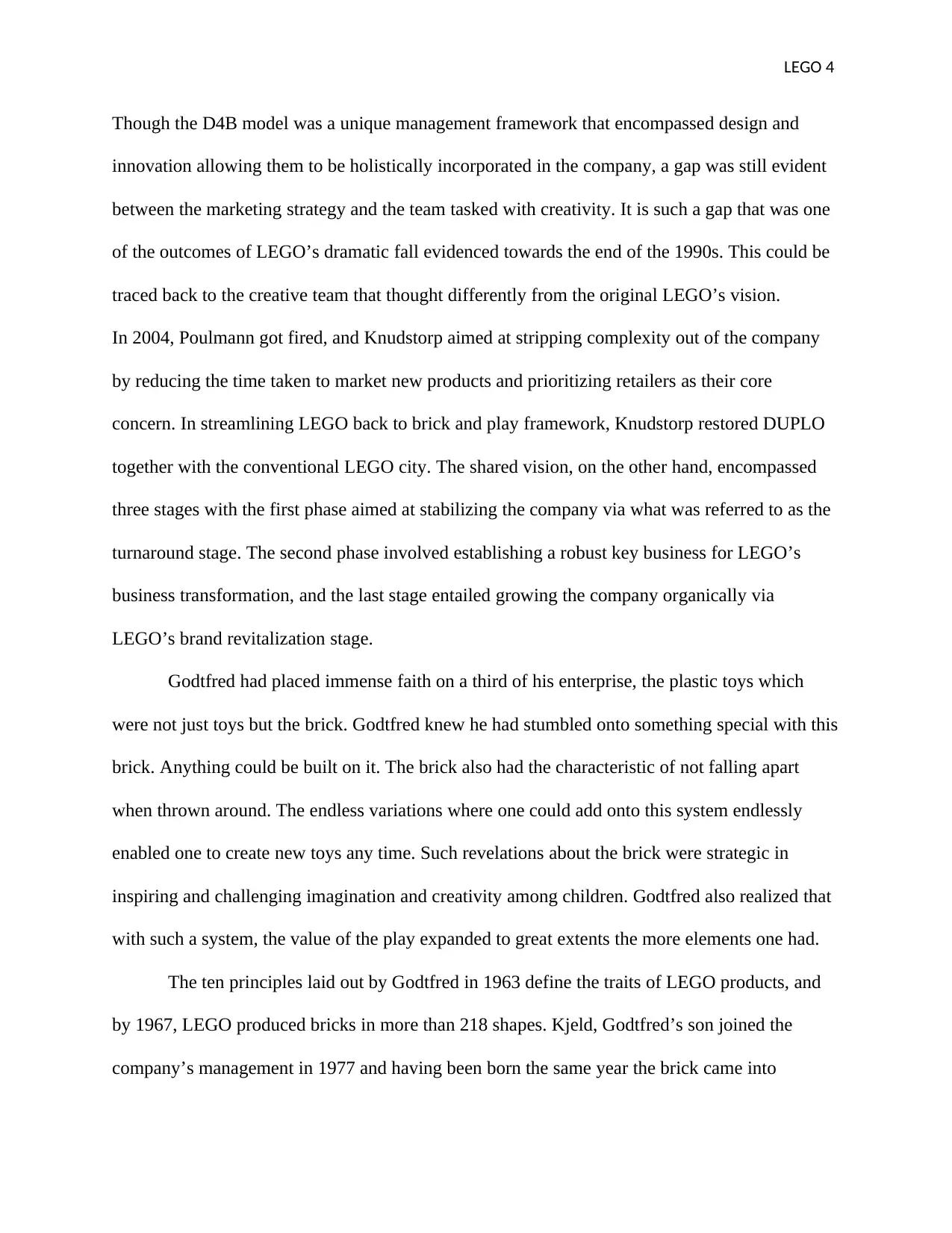
LEGO 4
Though the D4B model was a unique management framework that encompassed design and
innovation allowing them to be holistically incorporated in the company, a gap was still evident
between the marketing strategy and the team tasked with creativity. It is such a gap that was one
of the outcomes of LEGO’s dramatic fall evidenced towards the end of the 1990s. This could be
traced back to the creative team that thought differently from the original LEGO’s vision.
In 2004, Poulmann got fired, and Knudstorp aimed at stripping complexity out of the company
by reducing the time taken to market new products and prioritizing retailers as their core
concern. In streamlining LEGO back to brick and play framework, Knudstorp restored DUPLO
together with the conventional LEGO city. The shared vision, on the other hand, encompassed
three stages with the first phase aimed at stabilizing the company via what was referred to as the
turnaround stage. The second phase involved establishing a robust key business for LEGO’s
business transformation, and the last stage entailed growing the company organically via
LEGO’s brand revitalization stage.
Godtfred had placed immense faith on a third of his enterprise, the plastic toys which
were not just toys but the brick. Godtfred knew he had stumbled onto something special with this
brick. Anything could be built on it. The brick also had the characteristic of not falling apart
when thrown around. The endless variations where one could add onto this system endlessly
enabled one to create new toys any time. Such revelations about the brick were strategic in
inspiring and challenging imagination and creativity among children. Godtfred also realized that
with such a system, the value of the play expanded to great extents the more elements one had.
The ten principles laid out by Godtfred in 1963 define the traits of LEGO products, and
by 1967, LEGO produced bricks in more than 218 shapes. Kjeld, Godtfred’s son joined the
company’s management in 1977 and having been born the same year the brick came into
Though the D4B model was a unique management framework that encompassed design and
innovation allowing them to be holistically incorporated in the company, a gap was still evident
between the marketing strategy and the team tasked with creativity. It is such a gap that was one
of the outcomes of LEGO’s dramatic fall evidenced towards the end of the 1990s. This could be
traced back to the creative team that thought differently from the original LEGO’s vision.
In 2004, Poulmann got fired, and Knudstorp aimed at stripping complexity out of the company
by reducing the time taken to market new products and prioritizing retailers as their core
concern. In streamlining LEGO back to brick and play framework, Knudstorp restored DUPLO
together with the conventional LEGO city. The shared vision, on the other hand, encompassed
three stages with the first phase aimed at stabilizing the company via what was referred to as the
turnaround stage. The second phase involved establishing a robust key business for LEGO’s
business transformation, and the last stage entailed growing the company organically via
LEGO’s brand revitalization stage.
Godtfred had placed immense faith on a third of his enterprise, the plastic toys which
were not just toys but the brick. Godtfred knew he had stumbled onto something special with this
brick. Anything could be built on it. The brick also had the characteristic of not falling apart
when thrown around. The endless variations where one could add onto this system endlessly
enabled one to create new toys any time. Such revelations about the brick were strategic in
inspiring and challenging imagination and creativity among children. Godtfred also realized that
with such a system, the value of the play expanded to great extents the more elements one had.
The ten principles laid out by Godtfred in 1963 define the traits of LEGO products, and
by 1967, LEGO produced bricks in more than 218 shapes. Kjeld, Godtfred’s son joined the
company’s management in 1977 and having been born the same year the brick came into
Paraphrase This Document
Need a fresh take? Get an instant paraphrase of this document with our AI Paraphraser
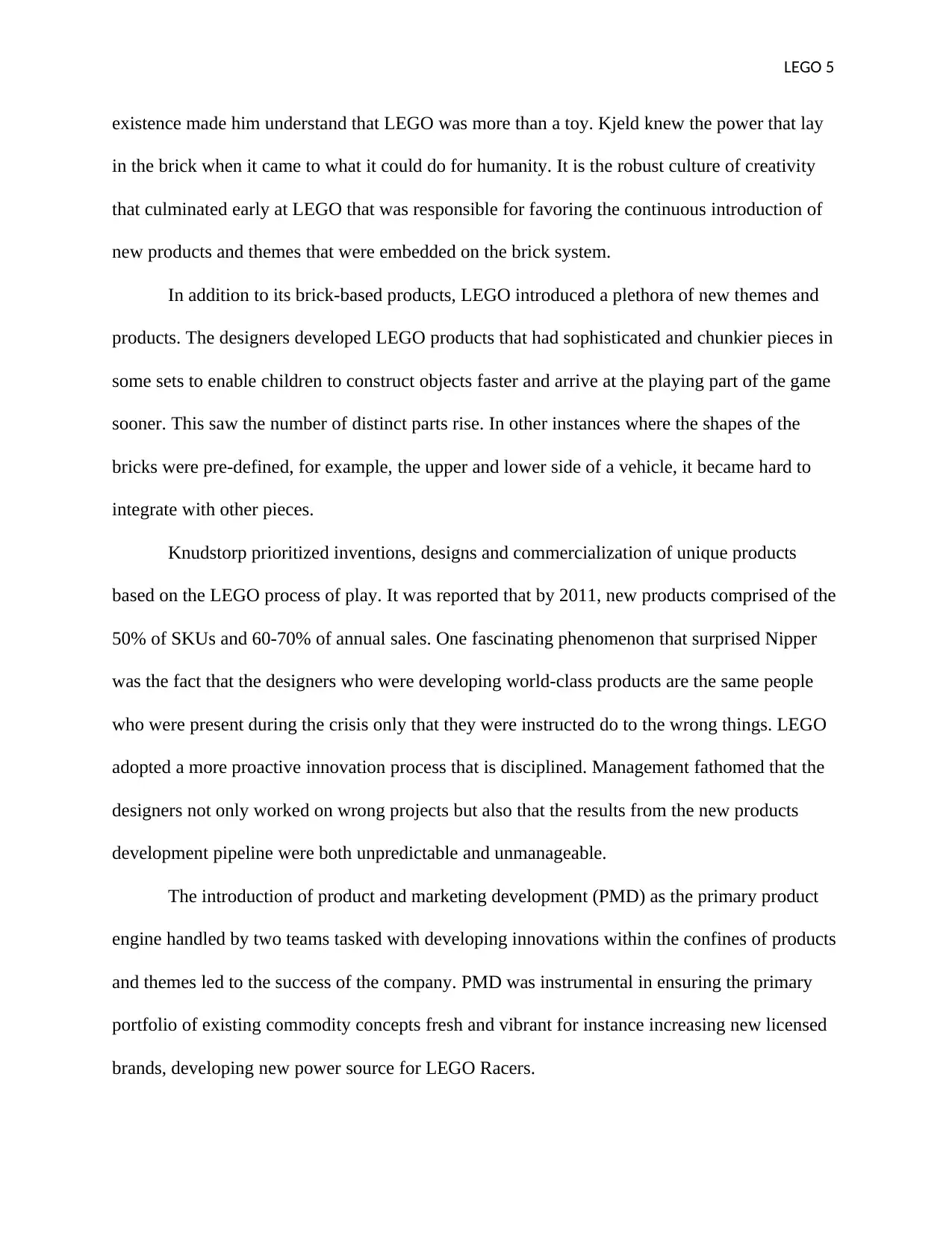
LEGO 5
existence made him understand that LEGO was more than a toy. Kjeld knew the power that lay
in the brick when it came to what it could do for humanity. It is the robust culture of creativity
that culminated early at LEGO that was responsible for favoring the continuous introduction of
new products and themes that were embedded on the brick system.
In addition to its brick-based products, LEGO introduced a plethora of new themes and
products. The designers developed LEGO products that had sophisticated and chunkier pieces in
some sets to enable children to construct objects faster and arrive at the playing part of the game
sooner. This saw the number of distinct parts rise. In other instances where the shapes of the
bricks were pre-defined, for example, the upper and lower side of a vehicle, it became hard to
integrate with other pieces.
Knudstorp prioritized inventions, designs and commercialization of unique products
based on the LEGO process of play. It was reported that by 2011, new products comprised of the
50% of SKUs and 60-70% of annual sales. One fascinating phenomenon that surprised Nipper
was the fact that the designers who were developing world-class products are the same people
who were present during the crisis only that they were instructed do to the wrong things. LEGO
adopted a more proactive innovation process that is disciplined. Management fathomed that the
designers not only worked on wrong projects but also that the results from the new products
development pipeline were both unpredictable and unmanageable.
The introduction of product and marketing development (PMD) as the primary product
engine handled by two teams tasked with developing innovations within the confines of products
and themes led to the success of the company. PMD was instrumental in ensuring the primary
portfolio of existing commodity concepts fresh and vibrant for instance increasing new licensed
brands, developing new power source for LEGO Racers.
existence made him understand that LEGO was more than a toy. Kjeld knew the power that lay
in the brick when it came to what it could do for humanity. It is the robust culture of creativity
that culminated early at LEGO that was responsible for favoring the continuous introduction of
new products and themes that were embedded on the brick system.
In addition to its brick-based products, LEGO introduced a plethora of new themes and
products. The designers developed LEGO products that had sophisticated and chunkier pieces in
some sets to enable children to construct objects faster and arrive at the playing part of the game
sooner. This saw the number of distinct parts rise. In other instances where the shapes of the
bricks were pre-defined, for example, the upper and lower side of a vehicle, it became hard to
integrate with other pieces.
Knudstorp prioritized inventions, designs and commercialization of unique products
based on the LEGO process of play. It was reported that by 2011, new products comprised of the
50% of SKUs and 60-70% of annual sales. One fascinating phenomenon that surprised Nipper
was the fact that the designers who were developing world-class products are the same people
who were present during the crisis only that they were instructed do to the wrong things. LEGO
adopted a more proactive innovation process that is disciplined. Management fathomed that the
designers not only worked on wrong projects but also that the results from the new products
development pipeline were both unpredictable and unmanageable.
The introduction of product and marketing development (PMD) as the primary product
engine handled by two teams tasked with developing innovations within the confines of products
and themes led to the success of the company. PMD was instrumental in ensuring the primary
portfolio of existing commodity concepts fresh and vibrant for instance increasing new licensed
brands, developing new power source for LEGO Racers.
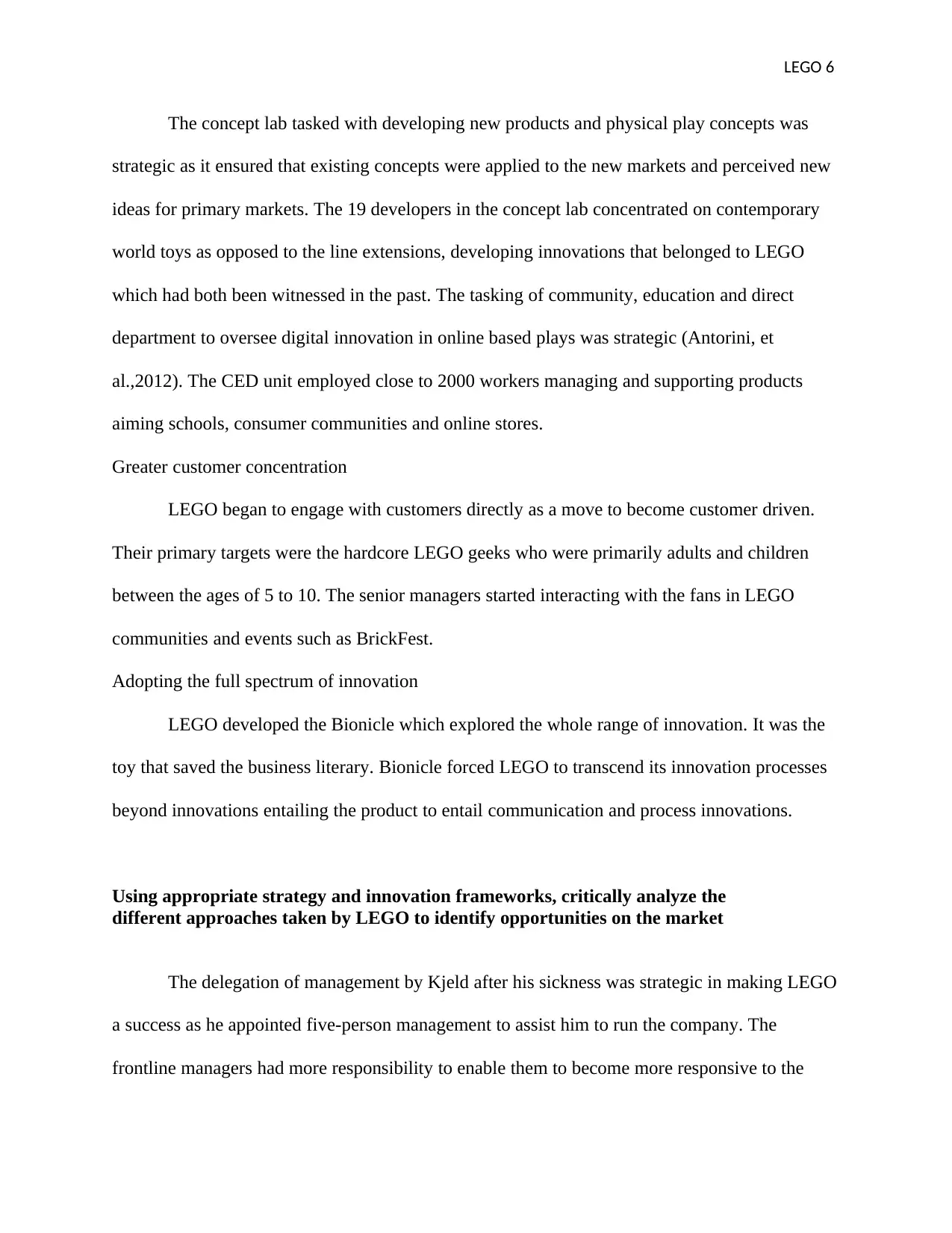
LEGO 6
The concept lab tasked with developing new products and physical play concepts was
strategic as it ensured that existing concepts were applied to the new markets and perceived new
ideas for primary markets. The 19 developers in the concept lab concentrated on contemporary
world toys as opposed to the line extensions, developing innovations that belonged to LEGO
which had both been witnessed in the past. The tasking of community, education and direct
department to oversee digital innovation in online based plays was strategic (Antorini, et
al.,2012). The CED unit employed close to 2000 workers managing and supporting products
aiming schools, consumer communities and online stores.
Greater customer concentration
LEGO began to engage with customers directly as a move to become customer driven.
Their primary targets were the hardcore LEGO geeks who were primarily adults and children
between the ages of 5 to 10. The senior managers started interacting with the fans in LEGO
communities and events such as BrickFest.
Adopting the full spectrum of innovation
LEGO developed the Bionicle which explored the whole range of innovation. It was the
toy that saved the business literary. Bionicle forced LEGO to transcend its innovation processes
beyond innovations entailing the product to entail communication and process innovations.
Using appropriate strategy and innovation frameworks, critically analyze the
different approaches taken by LEGO to identify opportunities on the market
The delegation of management by Kjeld after his sickness was strategic in making LEGO
a success as he appointed five-person management to assist him to run the company. The
frontline managers had more responsibility to enable them to become more responsive to the
The concept lab tasked with developing new products and physical play concepts was
strategic as it ensured that existing concepts were applied to the new markets and perceived new
ideas for primary markets. The 19 developers in the concept lab concentrated on contemporary
world toys as opposed to the line extensions, developing innovations that belonged to LEGO
which had both been witnessed in the past. The tasking of community, education and direct
department to oversee digital innovation in online based plays was strategic (Antorini, et
al.,2012). The CED unit employed close to 2000 workers managing and supporting products
aiming schools, consumer communities and online stores.
Greater customer concentration
LEGO began to engage with customers directly as a move to become customer driven.
Their primary targets were the hardcore LEGO geeks who were primarily adults and children
between the ages of 5 to 10. The senior managers started interacting with the fans in LEGO
communities and events such as BrickFest.
Adopting the full spectrum of innovation
LEGO developed the Bionicle which explored the whole range of innovation. It was the
toy that saved the business literary. Bionicle forced LEGO to transcend its innovation processes
beyond innovations entailing the product to entail communication and process innovations.
Using appropriate strategy and innovation frameworks, critically analyze the
different approaches taken by LEGO to identify opportunities on the market
The delegation of management by Kjeld after his sickness was strategic in making LEGO
a success as he appointed five-person management to assist him to run the company. The
frontline managers had more responsibility to enable them to become more responsive to the
⊘ This is a preview!⊘
Do you want full access?
Subscribe today to unlock all pages.

Trusted by 1+ million students worldwide
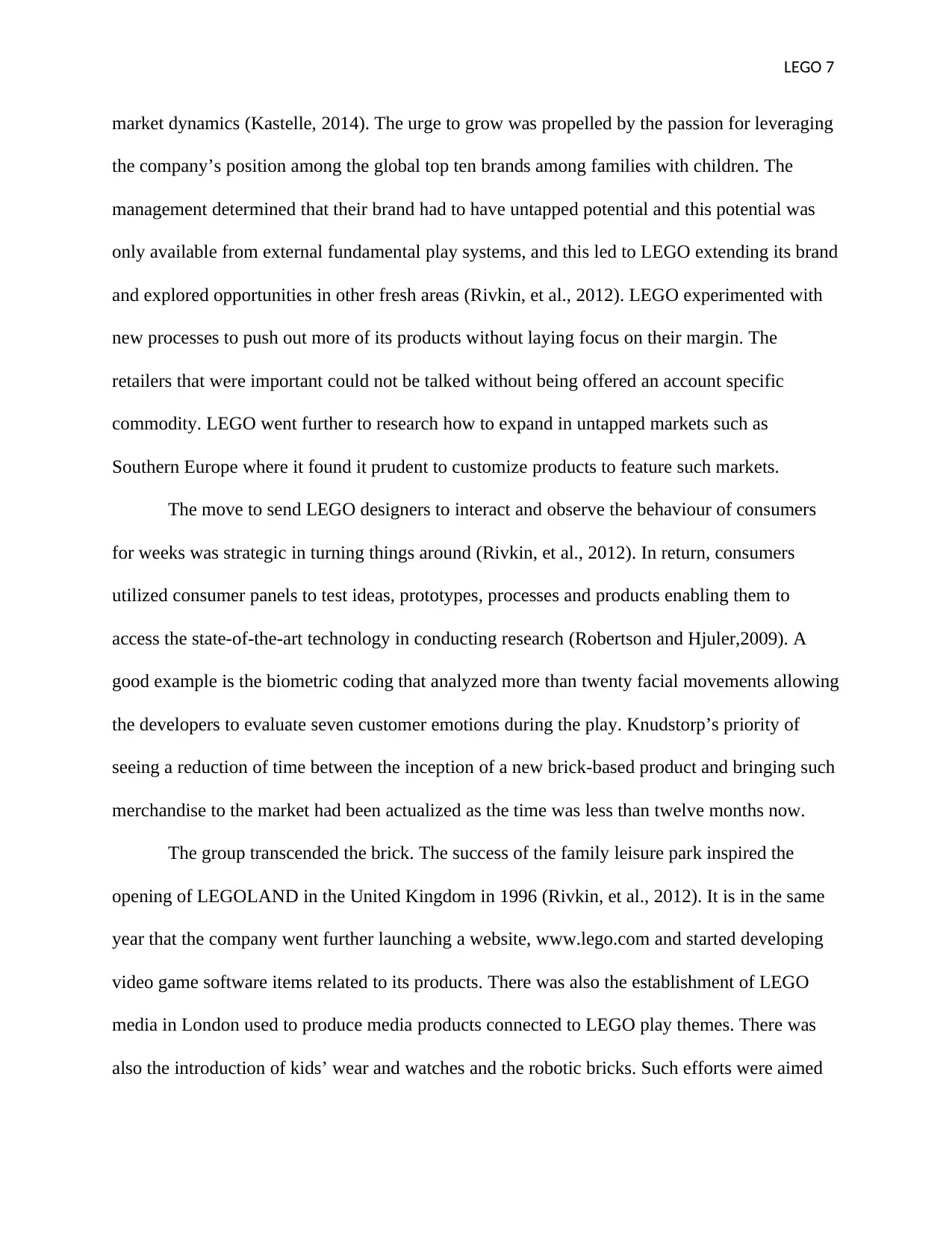
LEGO 7
market dynamics (Kastelle, 2014). The urge to grow was propelled by the passion for leveraging
the company’s position among the global top ten brands among families with children. The
management determined that their brand had to have untapped potential and this potential was
only available from external fundamental play systems, and this led to LEGO extending its brand
and explored opportunities in other fresh areas (Rivkin, et al., 2012). LEGO experimented with
new processes to push out more of its products without laying focus on their margin. The
retailers that were important could not be talked without being offered an account specific
commodity. LEGO went further to research how to expand in untapped markets such as
Southern Europe where it found it prudent to customize products to feature such markets.
The move to send LEGO designers to interact and observe the behaviour of consumers
for weeks was strategic in turning things around (Rivkin, et al., 2012). In return, consumers
utilized consumer panels to test ideas, prototypes, processes and products enabling them to
access the state-of-the-art technology in conducting research (Robertson and Hjuler,2009). A
good example is the biometric coding that analyzed more than twenty facial movements allowing
the developers to evaluate seven customer emotions during the play. Knudstorp’s priority of
seeing a reduction of time between the inception of a new brick-based product and bringing such
merchandise to the market had been actualized as the time was less than twelve months now.
The group transcended the brick. The success of the family leisure park inspired the
opening of LEGOLAND in the United Kingdom in 1996 (Rivkin, et al., 2012). It is in the same
year that the company went further launching a website, www.lego.com and started developing
video game software items related to its products. There was also the establishment of LEGO
media in London used to produce media products connected to LEGO play themes. There was
also the introduction of kids’ wear and watches and the robotic bricks. Such efforts were aimed
market dynamics (Kastelle, 2014). The urge to grow was propelled by the passion for leveraging
the company’s position among the global top ten brands among families with children. The
management determined that their brand had to have untapped potential and this potential was
only available from external fundamental play systems, and this led to LEGO extending its brand
and explored opportunities in other fresh areas (Rivkin, et al., 2012). LEGO experimented with
new processes to push out more of its products without laying focus on their margin. The
retailers that were important could not be talked without being offered an account specific
commodity. LEGO went further to research how to expand in untapped markets such as
Southern Europe where it found it prudent to customize products to feature such markets.
The move to send LEGO designers to interact and observe the behaviour of consumers
for weeks was strategic in turning things around (Rivkin, et al., 2012). In return, consumers
utilized consumer panels to test ideas, prototypes, processes and products enabling them to
access the state-of-the-art technology in conducting research (Robertson and Hjuler,2009). A
good example is the biometric coding that analyzed more than twenty facial movements allowing
the developers to evaluate seven customer emotions during the play. Knudstorp’s priority of
seeing a reduction of time between the inception of a new brick-based product and bringing such
merchandise to the market had been actualized as the time was less than twelve months now.
The group transcended the brick. The success of the family leisure park inspired the
opening of LEGOLAND in the United Kingdom in 1996 (Rivkin, et al., 2012). It is in the same
year that the company went further launching a website, www.lego.com and started developing
video game software items related to its products. There was also the establishment of LEGO
media in London used to produce media products connected to LEGO play themes. There was
also the introduction of kids’ wear and watches and the robotic bricks. Such efforts were aimed
Paraphrase This Document
Need a fresh take? Get an instant paraphrase of this document with our AI Paraphraser
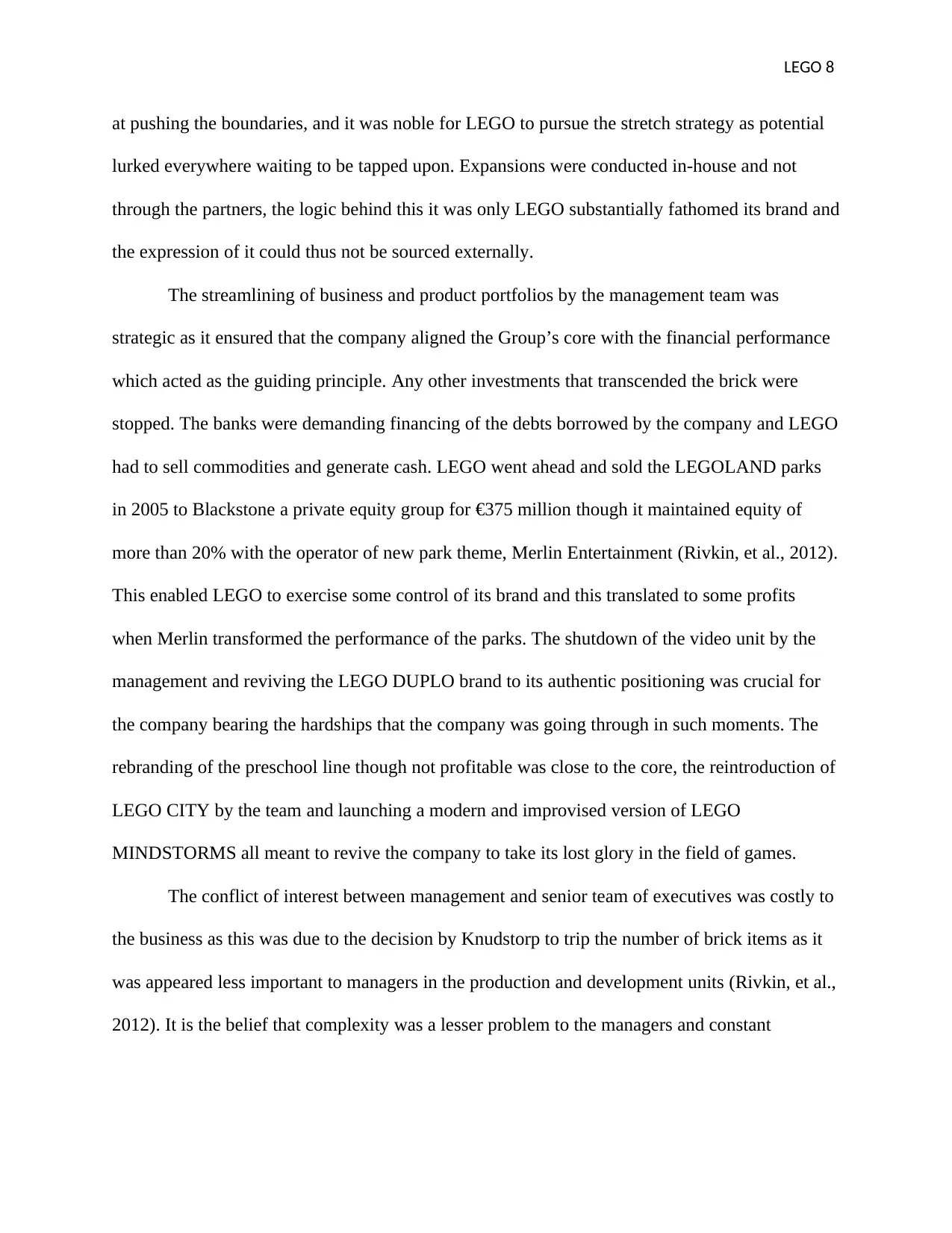
LEGO 8
at pushing the boundaries, and it was noble for LEGO to pursue the stretch strategy as potential
lurked everywhere waiting to be tapped upon. Expansions were conducted in-house and not
through the partners, the logic behind this it was only LEGO substantially fathomed its brand and
the expression of it could thus not be sourced externally.
The streamlining of business and product portfolios by the management team was
strategic as it ensured that the company aligned the Group’s core with the financial performance
which acted as the guiding principle. Any other investments that transcended the brick were
stopped. The banks were demanding financing of the debts borrowed by the company and LEGO
had to sell commodities and generate cash. LEGO went ahead and sold the LEGOLAND parks
in 2005 to Blackstone a private equity group for €375 million though it maintained equity of
more than 20% with the operator of new park theme, Merlin Entertainment (Rivkin, et al., 2012).
This enabled LEGO to exercise some control of its brand and this translated to some profits
when Merlin transformed the performance of the parks. The shutdown of the video unit by the
management and reviving the LEGO DUPLO brand to its authentic positioning was crucial for
the company bearing the hardships that the company was going through in such moments. The
rebranding of the preschool line though not profitable was close to the core, the reintroduction of
LEGO CITY by the team and launching a modern and improvised version of LEGO
MINDSTORMS all meant to revive the company to take its lost glory in the field of games.
The conflict of interest between management and senior team of executives was costly to
the business as this was due to the decision by Knudstorp to trip the number of brick items as it
was appeared less important to managers in the production and development units (Rivkin, et al.,
2012). It is the belief that complexity was a lesser problem to the managers and constant
at pushing the boundaries, and it was noble for LEGO to pursue the stretch strategy as potential
lurked everywhere waiting to be tapped upon. Expansions were conducted in-house and not
through the partners, the logic behind this it was only LEGO substantially fathomed its brand and
the expression of it could thus not be sourced externally.
The streamlining of business and product portfolios by the management team was
strategic as it ensured that the company aligned the Group’s core with the financial performance
which acted as the guiding principle. Any other investments that transcended the brick were
stopped. The banks were demanding financing of the debts borrowed by the company and LEGO
had to sell commodities and generate cash. LEGO went ahead and sold the LEGOLAND parks
in 2005 to Blackstone a private equity group for €375 million though it maintained equity of
more than 20% with the operator of new park theme, Merlin Entertainment (Rivkin, et al., 2012).
This enabled LEGO to exercise some control of its brand and this translated to some profits
when Merlin transformed the performance of the parks. The shutdown of the video unit by the
management and reviving the LEGO DUPLO brand to its authentic positioning was crucial for
the company bearing the hardships that the company was going through in such moments. The
rebranding of the preschool line though not profitable was close to the core, the reintroduction of
LEGO CITY by the team and launching a modern and improvised version of LEGO
MINDSTORMS all meant to revive the company to take its lost glory in the field of games.
The conflict of interest between management and senior team of executives was costly to
the business as this was due to the decision by Knudstorp to trip the number of brick items as it
was appeared less important to managers in the production and development units (Rivkin, et al.,
2012). It is the belief that complexity was a lesser problem to the managers and constant
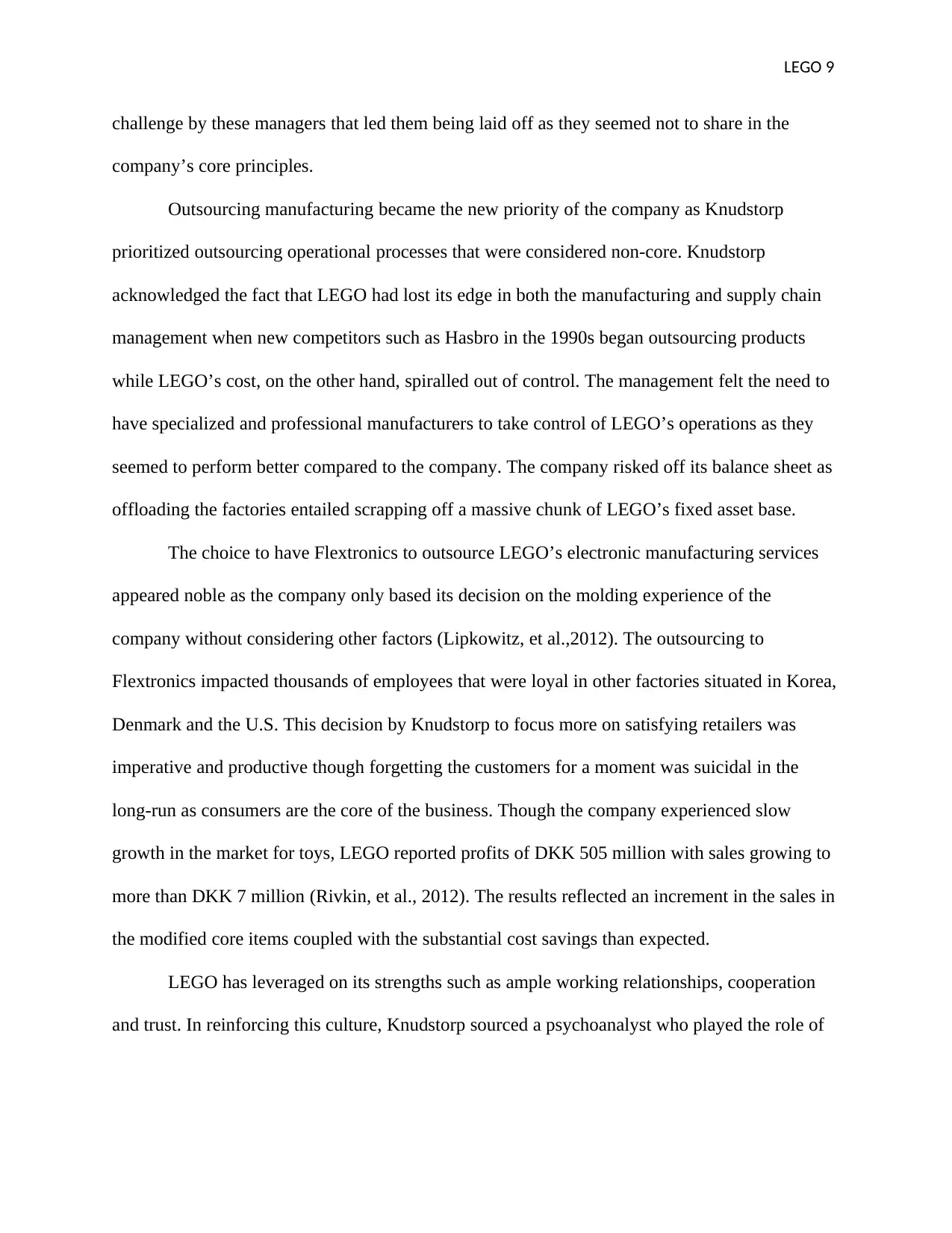
LEGO 9
challenge by these managers that led them being laid off as they seemed not to share in the
company’s core principles.
Outsourcing manufacturing became the new priority of the company as Knudstorp
prioritized outsourcing operational processes that were considered non-core. Knudstorp
acknowledged the fact that LEGO had lost its edge in both the manufacturing and supply chain
management when new competitors such as Hasbro in the 1990s began outsourcing products
while LEGO’s cost, on the other hand, spiralled out of control. The management felt the need to
have specialized and professional manufacturers to take control of LEGO’s operations as they
seemed to perform better compared to the company. The company risked off its balance sheet as
offloading the factories entailed scrapping off a massive chunk of LEGO’s fixed asset base.
The choice to have Flextronics to outsource LEGO’s electronic manufacturing services
appeared noble as the company only based its decision on the molding experience of the
company without considering other factors (Lipkowitz, et al.,2012). The outsourcing to
Flextronics impacted thousands of employees that were loyal in other factories situated in Korea,
Denmark and the U.S. This decision by Knudstorp to focus more on satisfying retailers was
imperative and productive though forgetting the customers for a moment was suicidal in the
long-run as consumers are the core of the business. Though the company experienced slow
growth in the market for toys, LEGO reported profits of DKK 505 million with sales growing to
more than DKK 7 million (Rivkin, et al., 2012). The results reflected an increment in the sales in
the modified core items coupled with the substantial cost savings than expected.
LEGO has leveraged on its strengths such as ample working relationships, cooperation
and trust. In reinforcing this culture, Knudstorp sourced a psychoanalyst who played the role of
challenge by these managers that led them being laid off as they seemed not to share in the
company’s core principles.
Outsourcing manufacturing became the new priority of the company as Knudstorp
prioritized outsourcing operational processes that were considered non-core. Knudstorp
acknowledged the fact that LEGO had lost its edge in both the manufacturing and supply chain
management when new competitors such as Hasbro in the 1990s began outsourcing products
while LEGO’s cost, on the other hand, spiralled out of control. The management felt the need to
have specialized and professional manufacturers to take control of LEGO’s operations as they
seemed to perform better compared to the company. The company risked off its balance sheet as
offloading the factories entailed scrapping off a massive chunk of LEGO’s fixed asset base.
The choice to have Flextronics to outsource LEGO’s electronic manufacturing services
appeared noble as the company only based its decision on the molding experience of the
company without considering other factors (Lipkowitz, et al.,2012). The outsourcing to
Flextronics impacted thousands of employees that were loyal in other factories situated in Korea,
Denmark and the U.S. This decision by Knudstorp to focus more on satisfying retailers was
imperative and productive though forgetting the customers for a moment was suicidal in the
long-run as consumers are the core of the business. Though the company experienced slow
growth in the market for toys, LEGO reported profits of DKK 505 million with sales growing to
more than DKK 7 million (Rivkin, et al., 2012). The results reflected an increment in the sales in
the modified core items coupled with the substantial cost savings than expected.
LEGO has leveraged on its strengths such as ample working relationships, cooperation
and trust. In reinforcing this culture, Knudstorp sourced a psychoanalyst who played the role of
⊘ This is a preview!⊘
Do you want full access?
Subscribe today to unlock all pages.

Trusted by 1+ million students worldwide
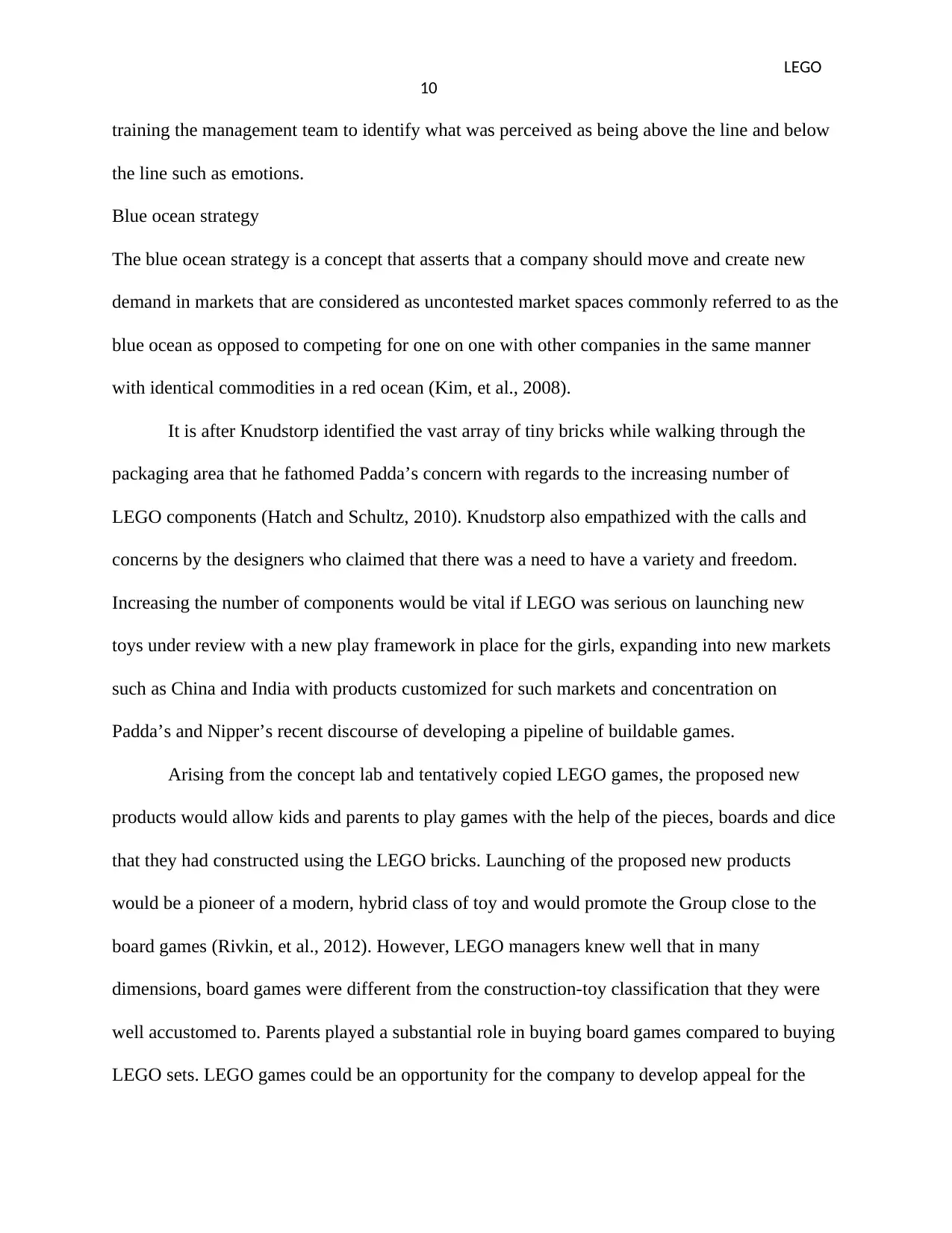
LEGO
10
training the management team to identify what was perceived as being above the line and below
the line such as emotions.
Blue ocean strategy
The blue ocean strategy is a concept that asserts that a company should move and create new
demand in markets that are considered as uncontested market spaces commonly referred to as the
blue ocean as opposed to competing for one on one with other companies in the same manner
with identical commodities in a red ocean (Kim, et al., 2008).
It is after Knudstorp identified the vast array of tiny bricks while walking through the
packaging area that he fathomed Padda’s concern with regards to the increasing number of
LEGO components (Hatch and Schultz, 2010). Knudstorp also empathized with the calls and
concerns by the designers who claimed that there was a need to have a variety and freedom.
Increasing the number of components would be vital if LEGO was serious on launching new
toys under review with a new play framework in place for the girls, expanding into new markets
such as China and India with products customized for such markets and concentration on
Padda’s and Nipper’s recent discourse of developing a pipeline of buildable games.
Arising from the concept lab and tentatively copied LEGO games, the proposed new
products would allow kids and parents to play games with the help of the pieces, boards and dice
that they had constructed using the LEGO bricks. Launching of the proposed new products
would be a pioneer of a modern, hybrid class of toy and would promote the Group close to the
board games (Rivkin, et al., 2012). However, LEGO managers knew well that in many
dimensions, board games were different from the construction-toy classification that they were
well accustomed to. Parents played a substantial role in buying board games compared to buying
LEGO sets. LEGO games could be an opportunity for the company to develop appeal for the
10
training the management team to identify what was perceived as being above the line and below
the line such as emotions.
Blue ocean strategy
The blue ocean strategy is a concept that asserts that a company should move and create new
demand in markets that are considered as uncontested market spaces commonly referred to as the
blue ocean as opposed to competing for one on one with other companies in the same manner
with identical commodities in a red ocean (Kim, et al., 2008).
It is after Knudstorp identified the vast array of tiny bricks while walking through the
packaging area that he fathomed Padda’s concern with regards to the increasing number of
LEGO components (Hatch and Schultz, 2010). Knudstorp also empathized with the calls and
concerns by the designers who claimed that there was a need to have a variety and freedom.
Increasing the number of components would be vital if LEGO was serious on launching new
toys under review with a new play framework in place for the girls, expanding into new markets
such as China and India with products customized for such markets and concentration on
Padda’s and Nipper’s recent discourse of developing a pipeline of buildable games.
Arising from the concept lab and tentatively copied LEGO games, the proposed new
products would allow kids and parents to play games with the help of the pieces, boards and dice
that they had constructed using the LEGO bricks. Launching of the proposed new products
would be a pioneer of a modern, hybrid class of toy and would promote the Group close to the
board games (Rivkin, et al., 2012). However, LEGO managers knew well that in many
dimensions, board games were different from the construction-toy classification that they were
well accustomed to. Parents played a substantial role in buying board games compared to buying
LEGO sets. LEGO games could be an opportunity for the company to develop appeal for the
Paraphrase This Document
Need a fresh take? Get an instant paraphrase of this document with our AI Paraphraser
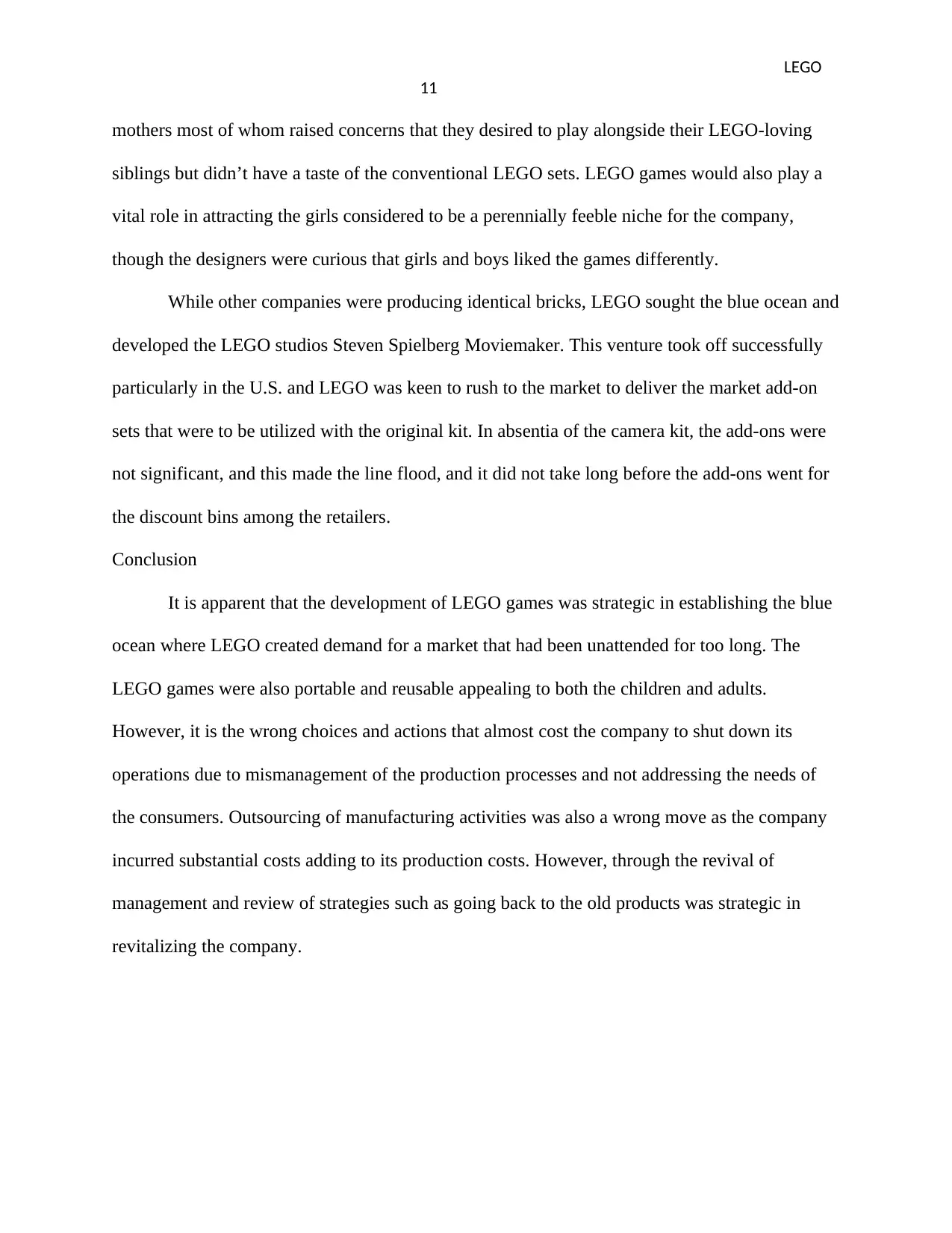
LEGO
11
mothers most of whom raised concerns that they desired to play alongside their LEGO-loving
siblings but didn’t have a taste of the conventional LEGO sets. LEGO games would also play a
vital role in attracting the girls considered to be a perennially feeble niche for the company,
though the designers were curious that girls and boys liked the games differently.
While other companies were producing identical bricks, LEGO sought the blue ocean and
developed the LEGO studios Steven Spielberg Moviemaker. This venture took off successfully
particularly in the U.S. and LEGO was keen to rush to the market to deliver the market add-on
sets that were to be utilized with the original kit. In absentia of the camera kit, the add-ons were
not significant, and this made the line flood, and it did not take long before the add-ons went for
the discount bins among the retailers.
Conclusion
It is apparent that the development of LEGO games was strategic in establishing the blue
ocean where LEGO created demand for a market that had been unattended for too long. The
LEGO games were also portable and reusable appealing to both the children and adults.
However, it is the wrong choices and actions that almost cost the company to shut down its
operations due to mismanagement of the production processes and not addressing the needs of
the consumers. Outsourcing of manufacturing activities was also a wrong move as the company
incurred substantial costs adding to its production costs. However, through the revival of
management and review of strategies such as going back to the old products was strategic in
revitalizing the company.
11
mothers most of whom raised concerns that they desired to play alongside their LEGO-loving
siblings but didn’t have a taste of the conventional LEGO sets. LEGO games would also play a
vital role in attracting the girls considered to be a perennially feeble niche for the company,
though the designers were curious that girls and boys liked the games differently.
While other companies were producing identical bricks, LEGO sought the blue ocean and
developed the LEGO studios Steven Spielberg Moviemaker. This venture took off successfully
particularly in the U.S. and LEGO was keen to rush to the market to deliver the market add-on
sets that were to be utilized with the original kit. In absentia of the camera kit, the add-ons were
not significant, and this made the line flood, and it did not take long before the add-ons went for
the discount bins among the retailers.
Conclusion
It is apparent that the development of LEGO games was strategic in establishing the blue
ocean where LEGO created demand for a market that had been unattended for too long. The
LEGO games were also portable and reusable appealing to both the children and adults.
However, it is the wrong choices and actions that almost cost the company to shut down its
operations due to mismanagement of the production processes and not addressing the needs of
the consumers. Outsourcing of manufacturing activities was also a wrong move as the company
incurred substantial costs adding to its production costs. However, through the revival of
management and review of strategies such as going back to the old products was strategic in
revitalizing the company.
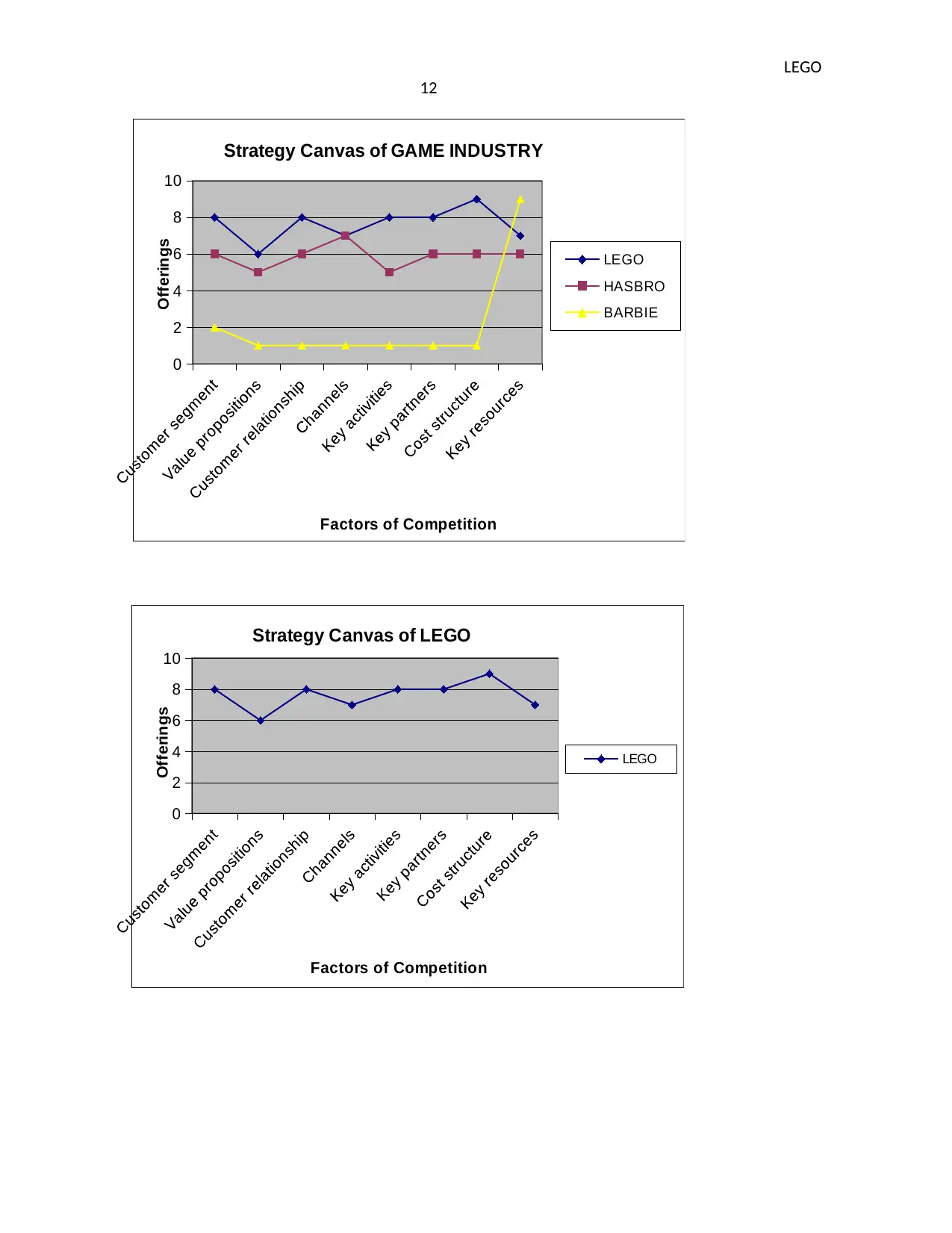
LEGO
12
0
2
4
6
8
10
Strategy Canvas of GAME INDUSTRY
LEGO
HASBRO
BARBIE
Factors of Competition
Offerings
0
2
4
6
8
10
Strategy Canvas of LEGO
LEGO
Factors of Competition
Offerings
12
0
2
4
6
8
10
Strategy Canvas of GAME INDUSTRY
LEGO
HASBRO
BARBIE
Factors of Competition
Offerings
0
2
4
6
8
10
Strategy Canvas of LEGO
LEGO
Factors of Competition
Offerings
⊘ This is a preview!⊘
Do you want full access?
Subscribe today to unlock all pages.

Trusted by 1+ million students worldwide
1 out of 14
Related Documents
Your All-in-One AI-Powered Toolkit for Academic Success.
+13062052269
info@desklib.com
Available 24*7 on WhatsApp / Email
![[object Object]](/_next/static/media/star-bottom.7253800d.svg)
Unlock your academic potential
Copyright © 2020–2025 A2Z Services. All Rights Reserved. Developed and managed by ZUCOL.



